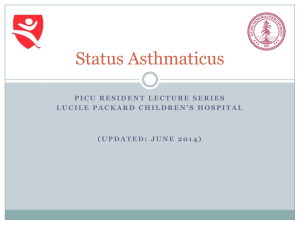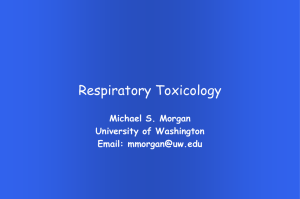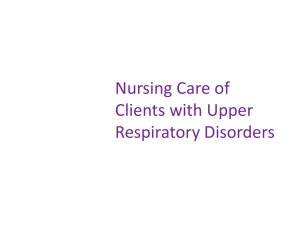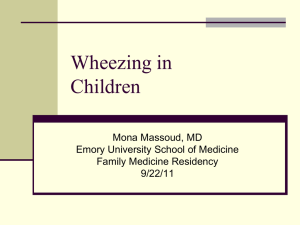401-Chronic-Resp
advertisement
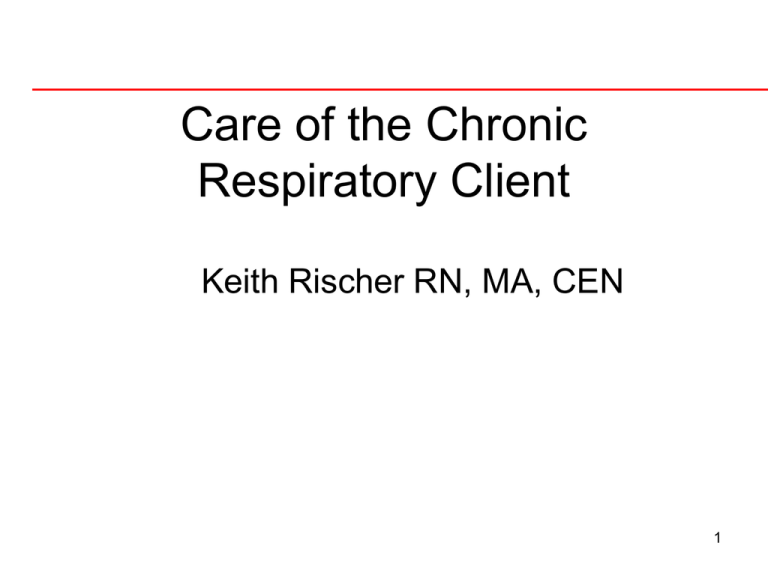
Care of the Chronic Respiratory Client Keith Rischer RN, MA, CEN 1 Todays Objectives Compare & contrast pathophysiology and clinical manifestations of asthma, emphysema, bronchitis & lung cancer. Identify the diagnostic tests, nursing priorities, and client education with asthma, emphysema, bronchitis, & lung cancer. Describe the mechanism of action, side effects and nursing responsibilities with pharmacologic management of asthma, emphysema & bronchitis. Contrast and compare medical vs. surgical management for treatment of lung cancer. Identify nursing priorities and care of the client with a chest tube. Identify nursing priorities and care of the client on a mechanical ventilator. 2 3 Obstructive Airway Disorders COPD Increase resistance to airflow Bronchi smooth muscle innervated by autonomic nervous system • Parasympathetic stimulation • Sympathetic stimulation • Inflammatory mediator response COPD • Chronic-recurrent obstruction Emphysema bronchitis 4 Obstructive Disorders:Asthma Patho • Intermittent & reversible airway obstruction INFLAMMATION-Chronic – Antibody molecules (IgE) – Mast cells>histamine>WBC – Physiological response to inflammation » Vessel dilation>capillary leakage>tissue swelling>incr. secretions Airway hyper-responsiveness Childhood – Allergens – smoking – Cold/dry air – Bacteria Bronchospasm – edema & mucous 5 What is a Mast Cell? Bag of Granules Located in connective tissue • close to blood vessels Histamine released • Increase blood flow • Increase vascular permeability • Binds to H1, H2 receptors 6 Etiology of asthma Intrinsic etiologies • uncertain causes • physical or psychological stress • exercise-induced Extrinsic etiologies • antigen-antibody (allergic) reaction to specific irritants air pollutants sinusitis cold and dry air Meds-ASA food additives hormonal influences GE reflux 7 Clinical manifestations of Asthma Severe dyspnea • • wheezing with expiration or inspiration Which is worse… Tachypnea Cough Feelings of chest tightness Prolonged expiration Diminished breath sounds Increased heart rate and blood pressure Restlessness, anxiety, agitation 8 Asthma: Lab & Dx Findings Decreased pO2 Decreased pCO2 • • • Forced vital capacity (FVC) Peak flow meter ABG’s • • Early Late findings Elevated eosinophil count CXR Pulmonary Function Test • • • • pH 7.28 pO2-55 pCO2-60 HCO3-22 O2 sats-86% RA ABG’s • • • • • pH 7.35 pO2-75 pCO2-30 HCO3-22 O2 sats-90% RA 9 Pharmacologic Treatment Options Relievers = short-acting bronchodilators • quickly relieves bronchoconstriction and symptoms Controllers = daily medications taken on a long-term basis • • useful for controlling persistent asthma includes anti-inflammatory agents and long-acting bronchodilators 10 Beta-2 agonists chart 33-5 p.590-592 Mechanism • bronchodilation through bronchial smooth muscle relaxation mediated by beta-2 receptors in the lung Short Acting • albuterol (Proventil, Ventolin) Xopenex • Pirbuterol (Maxair autoinhaler) • Terbutaline (Brethaire) Long acting • Salmeterol-Serevent Onset: 5-15 minutes Duration: 4-6 hours 11 Beta-2 agonists Uses: • Rescue medication to relieve acute symptoms & prevention of bronchospasms prior to a precipitating event (e.g. exercise) Adverse effects: • • • • • Tachycardia Restlessness Tremors Palpitations paradoxical bronchoconstriction 12 Anticholinergics Mechanism • • block parasympathetic nervous system influence SNS dominates Ipratropium (Atrovent) Onset: 3-30 minutes, peak: 1-2 hours Duration: 4-8 hours Adverse effects • • drying of mouth and respiratory secretions increased wheezing in some individuals 13 Inhaled Corticosteroids Mechanism • • • Decrease inflammation block late reaction to allergens and reduce airway hyperresponsiveness inhibit microvascular leakage Common Meds…used qd • • • budesonide (Pulmocort) fluticasone (Flovent) triamcinolone (Azmacort) 14 Inhaled Corticosteroids (cont.) Uses: • • long-term prevention of symptoms (suppression, control, and reversal of inflammation) reduce/eliminate oral steroid use Adverse effects: • • oral candidiasis ??systemic effects at high doses 15 Oral Corticosteroids Common agents • Prednisone Uses • short term (3-10 days) “burst therapy” to gain prompt control of asthma • methylprednisolone (Medrol, Solu-Medrol) to prevent progression of exacerbation, speed recovery, and reduce relapse long-term prevention of symptoms in severe persistent asthma LT Side Effects • • • • • • HTN Peptic ulcers Skin fragility Impaired immunity Thromboembolism Cushingoid appearance 16 Asthma:Combination Inhalers Advair Diskus • • • Fluticasone Salmeterol (serevent) Frequency 1 inhalation q12 hours Combivent MDI • • • Ipratropium (atrovent) Albuterol Frequency 2 puffs 4 times daily 17 Asthma: Other Medications Leukotriene Antagonists • • • anti-inflammatory Montelukast (Singulair) Therapeutic response Decreased frequency & severity of attacks Decreased exercise induced bronchoconstriction Mast cell stabilizers • • • Mechanism Cromolyn sodium (Intal) Frequency 1-2 inhalations 4 times daily 18 Asthma:Regimen by Severity Mild • • Moderate • • Short-acting beta-agonist inhaler Anti-inflammatory inhaler used for mild symptoms occurring daily Anti-inflammatory inhaler plus medium-dose corticosteroid inhaler used for moderate symptoms occurring daily or more often Severe • • Anti-inflammatory inhaler plus long-acting bronchodilator plus oral corticosteroid used for severe symptoms occurring daily or more 19 Priority Nursing Diagnoses for Asthma Impaired gas exchange r/t… Ineffective breathing pattern r/t… Ineffective airway clearance r/t… Anxiety r/t… Deficient knowledge 20 Asthma:Critical Care Management Status asthmaticus/severe asthma Physical assessment • Dyspnea/tachypnea • Wheezing I/E • Diminished aeration to no air movement • Accessory muscles Medical management …remember A,B,C,s • O2 • Albuterol neb • Epinephrine subq • Establish IV • IV steroids (solumedrol) • Prepare for possible 21 intubation Planning and implementation for Asthma Assess respiratory and oxygenation status Administer supplemental oxygen as needed Administer broncholdilators as prescribed Observe characteristics of sputum Identify/avoid/remove precipitating factors Teach patient relaxation techniques Prepare for IV access Be prepared for intubation Diagnostic studies Emotional support for patient and family 22 Expected outcomes/evaluation Absence of dyspnea, chest tightness, wheezing Respiratory rate 12-20 breaths per minute Pulse oximetry/arterial blood gas values within normal range for client Bilaterally clear and equal breath sounds Afebrile Adequate airway clearance Absence/resolution of anxiety Clear chest x-ray or return to patient’s baseline Normal or improved peak flow 23 Asthma: Patient Education Identify asthma triggers Teach patient/family proper used of metereddose inhaler • Chart 33-6 p.593 Rescue inhalers! Instruct client regarding the use of peak flow meter for self-assessment of asthma status Asthma symptoms requiring emergency intervention 24 Emphysema 25 Emphysema: Patho Loss of lung elasticity • • Alveolar destruction Excessive enlargement Loss of “curves” impairs gas exchange Compensation… Hyperinflation of lung • • • Secondary to air trapping “barrel chest” appearance “Pink puffer O2 diffused easier than CO2 CO2 accumulates causing chronic resp. acidosis 26 Emphysema: Causes & Complications Cigarette smoking • • • Chronic respiratory inflammation • Pack years required Smoke>enzyme elastase protease>destroys alveoli Destroys cilia air pollution Complications • • • • Hypoxemia & acidosis Resp. infections/pneumonia Cur pulmonale Cardiac dysrhythmias 27 Emphysema: PhysicalAssessment…A,B,C’s General appearance • • Emaciated Barrel chest Airway/breathing • • • • • Dyspnea Tachypnea Accessory muscle use Pursed lip breathing Lung sounds • • overall diminished, and wheezes or crackles may be present Dry cough more so than productive O2 sats… Circulation • • tachycardia (inadequate oxygenation) Arrythmias 28 Emphysema: Diagnostic Tests ABGs • Chronic resp. acidosis • • Compensation w/HCO3 • Assess pO2, pCO2 and HCO3 • CBC • • • • WBC Hgb Hct ABG’s polycythemia • pH 7.35 pO2-55 pCO2-60 HCO3-22 O2 sats-86% RA ABG’s pH 7.35 Chest x-ray • pO2-55 • hyperinflated lungs with a flattened•diaphragm pCO2-60 • HCO3-35 • O2 sats-86% RA • 29 ED COPD Case Study 84yr female • • • • • PMH: COPD, asthma, HTN, anxiety, mitral stenosis HPI: productive cough of green phlegm the last 4 days. Primary MD started on po Prednisone and Abx. Developed incr. SOB through the night with pronounced fever/chills w/left shoulder pain that increases w/movement. Denies CP VS: T-103.2 P-122 (ST) R-36 BP-202/105 sats 88% RA Assessment: Neuro-a/o notably anxious Resp-diminished bilat w/exp. Wheezing CV-2/6 murmur 30 ED COPD Case Study Medical Priorities… Nursing priorities Nursing assessments… Nursing interventions… 31 ED COPD Case Study CXR • Large left lower lobe infiltrate Labs • BMP Na • 138, K+ 3.9, creat. 1.16, gluc 112 CBC WBC • 7.0, Hgb 13.3, Hct 39.9, plat. 217 UA neg 32 Chronic Bronchitis A disorder of chronic airway inflammation Major & small bronchioles • • Chronic productive cough lasting at least 3 months during 2 years Chronic exposure to irritants • smoking An inflammatory response in the small & large airways resulting in… Vasodilation Congestion mucosal edema broncospasm 33 Chronic Bronchitis: Patho Etiology • Smoking Chronic inflammation • Increase in # and size of mucous glands More mucous • bronchial walls thicken/edema airflow is impeded • Smaller airways are blocked Airflow and gas exchange impacted pO2… pCO2… • Cilia disappear, and the airway clearance function is lost • Unlike emphysema, cannot increase breathing efforts to maintain blood gases • “blue bloater” • Polycythemia 34 Chronic Bronchitis: Clinical Manifestations Productive cough • • Primarily occurring during winter season foul-smelling sputum Dyspnea and activity intolerance Frequent pulmonary infections “Blue bloater” • bluish-red skin discoloration from cyanosis and polycythemia Barrel chest 35 Emphysema/Bronchitis:Medical Management Goals • • improve ventilation promote patent airway by removal of secretions Remove environmental pollutants O2 and neb therapy Chest physiotherapy Mechanical ventilation Surgical procedure • • • bullectomy lung volume reduction lung transplantation 36 Emphysema/Bronchitis: Medications Beta-adrenergic agonists • Anticholinergics • • may be beneficial for pts. w/asthma history Immunizations • may be beneficial to strengthen diaphragm contractility and decrease work of breathing Corticosteroids • Atrovent administered as maintenance by inhaler most effective bronchodilators for COPD Theophylline • bronchodilators in COPD by nebs or MDI flu and pneumonia Abx 37 Emphysema/Bronchitis: Priority Nursing Dx p.600-606 Impaired gas exchange r/t… Ineffective breathing pattern r/t… Ineffective airway clearance r/t… Imbalanced nutrition r/t… Anxiety r/t… Activity intolerance r/t… Fatigue r/t… Deficient knowledge 38 Emphysema/Bronchitis: Nursing Care Priorities remember A,B,C’s… Administer low-flow O2 as needed Position patients to maintain effective breathing Closely monitor & assess resp. status • • • Provide education and referrals for pts. w/risk behaviors • Auscultation O2 sats Response to acute interventions/O2 Referral to smoking cessation Pulmonary conditioning program Develop appropriate nutritional plans Energy conservation Exercise conditioning Assess understanding to education 39 Emphysema/Bronchitis: Patient Education Smoking cessation Teach clients how to avoid occupational or environmental pollutants Pursed lip breathing Maintain adequate nutrition with emphasis on higher calorie intake Nutrition may be optimal with frequent small meals, and 1000-2000cc of fluid daily Teach energy conservation techniques 40 Emphysema/Bronchitis: Expected Outcomes Activity tolerance is optimized Pulmonary irritants such as smoking, air pollution, or occupational exposure are avoided Pulmonary infections are reduced in number and severity Nutritional intake is adequate but not excessive for individual energy needs 41 Pulmonary Tuberculosis Patho • • • Mycobacterium tuberculosis (bacillus) Most common bacterial infection globally Aerosolized Susceptible host • • • Nonspecific pneumonitis alveoli or bronchus 5-15% ultimately develop Cell mediated immunity 210 weeks later w/+ mantoux 42 Pulmonary Tuberculosis: Infection Inflammation in lungs surrounded by lymphocytes, collagen Caseation necrosis • Necrotic tissue turned into granular mass that become calcified Seen in low to middle lobes Can spread systemically to brain, liver , kidneys, bone marrow 43 Incidence HIV Immigrant populations Crowded areas • LTC, prison, Elderly Homeless Poverty 44 Physical Assessment/Diagnosis Fatigue, lethargy, nausea, weight loss Fever…night sweats Persistent cough…productive streaked w/blood Decreased aeration, crackles Diagnosis • • • Positive smear acid-fast bacillus + sputum culture…takes 1-3 weeks to confirm Mantoux 5-10mm induration 45 Treatment Combination • • chart 34-7 p.643 Isoniazid (INH) Rifampin Pt. education • • • • Compliance! 6 months treatment required Sputum specimens q2-4 weeks during therapy No longer contagious after 2-3 weeks of treatment Once negative x3 cured 46 Nursing Priorities Airborne precautions Ventilated room N-95 mask or PAPR for any staff entering room TB drugs can cause nausea-anticipate Nutrition 47 Lung Cancer: Patho Bronchial epithelium • • 90% primary Obstruction Histologic cell type • Small cell vs. non small cell • Adenocarcinoma Small cell 20% of all lung CA 99% correlation w/smoking 35% of all lung CA Spread between smokers and non smokers Metastasis • Circulatory & lymphatic 48 Lung Cancer: Clinical Manifestations Non-specific & occur late • Bronchitis/pneumonitis secondary to obstruction • • • Depend on type & location of tumor Chills Fever Cough Bloody sputum Dyspnea • • Use of accessory muscles Wheezing-diminished aeration 49 Lung Cancer: Diagnostic CXR CT Bronchoscopy • Bronchial washing Needle/surgical biopsy 50 Lung Cancer:Medical Management Non-surgical • Chemotherapy • N&V Mucositis Alopecia Immunosuppression Pan cytopenia Radiation Best results when used w/surgery or chemo Daily for 5-6 weeks Esophagitis…esophagus proximal to lungs Side effects – – – – Skin irritation & peeling Fatigue Nausea Taste changes 51 Lung Cancer:Medical Management Surgical • Thoracotomy • Lobectomy • Tumor removal Removal lobe of lung Pneumonectomy Entire lung 52 Lung Cancer: Thoracotomy-Postop p.618-622 Chest tube • • Drain placed in pleural space to restore intrapleural pressure Chest tube banded & connected to Pleurovac collection chamber w/several feet tubing Drainage system • First chamber • Second chamber • Drainage from client Water seal Third chamber suction 53 Chest Tube: Nursing Priorities Assess resp. status closely Check water seal for bubbling Milk NOT strip every 2 hours Assess color-amount drainage • Call MD if >100cc/hr x2 hours first 24 hours Sterile guaze/occlusive dressing at bedside 54 Mechanical Ventilation The use of an ET and POSITIVE pressure to deliver O2 at preset tidal volume Modes • Assist Control (AC) • Synchronized Intermittent Mandatory Ventilation (SIMV) • • TV & rate preset Additional resp. receive preset TV Additional resp. receive own TV Used for weaning Continuous Positive Airway Pressure (CPAP) Bi-pap Non-mechanical receive both insp. & exp. Pressures w/facemask 55 Mechanical Ventilation Terminology • • Rate Tidal volume • Fraction of inspired O2 concentration (FiO2) • • Use lowest possible to maintain O2 sats Positive End Expiratory Pressure (PEEP) Minute volume 10-15cc/kg RR x TV AC12-TV 600-50%-+5 56 Mechanical Ventilation: Adverse Effects Complications • • • • • • Aspiration Infection-VAP Stress ulcer of GI tract Tracheal damage Ventilator dependancy Decreased cardiac output • Positive pressure decr. venous return & CO Barotrauma pneumothorax 57 Mechanical Ventilation:Nursing Priorities Monitor VS-breath sounds closely Assess ET securement/length at lip Clearance of secretions • • • Sedation • Closed suction-maintains sterility Do not do routinely Pre-oxygenate Propofol Oral care Nutritional support 58 Mechanical Ventilation:Nursing Priorities Ventilator Alarm Troubleshooting • High pressure Secretions-needs sx Tubing obstructed or kinked Biting ET • Low pressure Disconnection of tubing Follow tubing from ET to ventilator 59 Oxygen Delivery Atmospheric room air %.......??? Nasal cannula • Add 3% for each liter of flow to FiO2 • 1-6 liters Oxymizer • Reservoir to increase FiO2 per liter delivery • 6-12 liters Face mask • 40-50% FiO2 • 8-15 liters Face mask w/non-rebreather • 90-100% FiO2 60 Respiratory Case Study Darrell Johnson is a 62-year-old male who comes to the Emergency Room with a 4-day history of increased sputum production, a change in the character of sputum, increased shortness of breath, and a fever of 101° F He has a smoking history of 2 packs a day for the past 20 years, and he smoked 1 pack a day prior to that beginning at the age of 14. He reports that he had asthma as a child, and that he has been treated with Albuterol inhalers from time to time as an adult. Mr. Johnson has been hospitalized twice with pneumonia, most recently 2 years ago. 61 Respiratory Case Study Physical exam reveals the following: Vital signs: T 101° F, P 115, R 30, BP 120/80 O2 sats 90% on room air Respirations shallow and labored, with use of respiratory accessory muscles. Increased anteroposterior (AP) diameter of the chest. Skin dry and warm to touch, with inelastic skin turgor, and fingernail clubbing present. 62 Respiratory Case Study Which assessment is most important for the nurse to complete next? A) Auscultate breath sounds. B) Determine pupillary response to light. C) Observe for jugular vein distention. D) Palpate pedal pulses. Which assessment finding supports Mr. Johnson's diagnosis of pneumonia? A) Pulse rate of 115. B) BP of 120/80. C) Increased AP diameter of the chest. D) Fingernail clubbing. 63 Respiratory Case Study Arterial Blood Gases were obtained with the following results: • • • • pH 7.28. pCO2 55. HCO3 25. pO2 89. Based on these ABG results, which acid base imbalance is Mr. Johnson experiencing? • A) Metabolic acidosis. B) Metabolic alkalosis. C) Respiratory acidosis. D) Respiratory alkalosis. 64 Respiratory Case Study Which nursing diagnosis has the highest priority when planning care for Mr. Johnson? • A) Altered nutrition, less than body requirements. B) Activity intolerance. C) Anxiety related to increased shortness of breath. D) Ineffective airway clearance. 65 Respiratory Case Study Mr. Johnson is admitted to his room on the Medical Nursing Unit. The healthcare provider prescribes the following: • • • • • • • Bedrest with bedside commode. O2 at 2 L/minute via nasal cannula. Diet as tolerated. Continuous O2 saturation monitoring via pulse oximeter. IV fluid of 5% Dextrose and 0.45 Normal Saline at 3 liters per day. Obtain a sputum culture. Medications include: Ampicillin (Unasyn) 1 gm IVPB every 6 hours. Nebulizer treatments every 4 hours and PRN with saline and albuterol (Ventolin). Triamcinolone (Azmacort) inhaler, 2 puffs twice a day. Albuterol (Ventolin) inhaler, 2 puffs 4 times a day. Methylprednisolone (Solu-Medrol) 125 mg IVPB every 8 hours. 66 Respiratory Case Study Which nursing action should be implemented before administering the prescribed Unasyn? • A) Assess the apical heart rate. B) Obtain O2 saturation recording. C) Obtain a sputum culture. D) Record Mr. Johnson's weight. Which assessment is most important for the nurse to perform while Mr. Johnson is receiving Ventolin? • A) Monitor temperature. B) Measure intake and output. C) Monitor pulse and BP. D) Measure central venous pressure (CVP). 67 Respiratory Case Study The nurse observes Mr. Johnson as he uses his inhalers. Using a spacer, he takes 2 puffs of the Ventolin, followed a minute later by 2 puffs of the Azmacort. After observing Mr. Johnson, what client teaching should the nurse initiate? • A) "Administer the Azmacort first, followed by the Ventolin." B) "Using a spacer reduces medication absorption." C) "Inhale deeply before sealing the mouthpiece." D) "Wait at least one minute between each puff of the same medication." Which instruction should the nurse provide Mr. Johnson for an acute episode of asthma? • A) "Administer the Azmacort as soon as possible." B) "Use the Ventolin inhaler for acute asthma attacks." C) "Call your healthcare provider before administering any medication." D) "You will need IV Solu-Medrol for your next acute attack." 68 Respiratory Case Study Continuous monitoring of Mr. Johnson's oxygen saturation indicates readings ranging between 90%-91%. After checking the sensor site to make sure the readings are accurate, which intervention should the nurse initiate next? • A) Increase the oxygen to 6 L/minute per nasal cannula. B) Elevate the head of the bed to a high-Fowler's position. C) Remove the pulse oximeter to reduce anxiety. D) Obtain and administer a prescription for pain relief. Which action should the nurse implement to ensure accurate oxygen saturation readings via a pulse oximeter? • A) Elevate the extremity to which the sensor is attached. B) Assess adequacy of circulation prior to applying the sensor. C) Keep the sensor exposed to adequate lighting. D) Remove the sensor when taking the B/P. 69 Respiratory Case Study During the night, Mr. Johnson calls the nurse to report a sudden inability to catch his breath. Upon assessment, the nurse notes that Mr. Johnson's respiratory rate has increased to 40 with obvious dyspnea, and his O2 saturation reading is 55. His pulse is 110, weak, and thready, and his blood pressure is 70/40. Which interventions should the nurse initiate immediately? • A) Place resusitation equipment in the room. B) administer high flow O2 C) establish IV access and initiate IV fluid resuscitation D) Initiate CPR. 70 Respiratory Case Study The remainder of Mr. Johnson's hospital stay is uneventful and is transferred back to the floor Which outcome statement is the best indicator that Mr. Johnson's pneumonia is resolved and he is ready to be discharged? A) Sputum culture is negative. B) Unasyn peak and trough levels are within normal limits. C) Oxygen saturation level is 92%. D) Temperature is 98° F. Which additional discharge instruction should the nurse include in the teaching plan to promote optimal health for Mr. Johnson? A) Avoid physical exertion. B) Avoid crowds and people with infections. C) Limit intake of oral fluids. D) Stay indoors except in the early morning. 71


